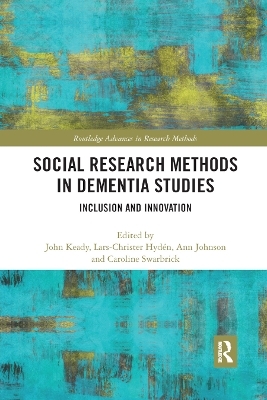
Social Research Methods in Dementia Studies
Routledge (Verlag)
978-0-367-87870-2 (ISBN)
A ground-breaking book, Social Research Methods in Dementia Studies shows researchers how to adapt their methods of data collection to address the individual needs of someone who is living with dementia. With an editorial team that includes Ann Johnson, a trained nurse and person living with dementia, this enlightening volume mainly draws its contents from two interdisciplinary social research teams in dementia, namely the Center for Dementia Research [CEDER] at Linköping University in Norrköping, Sweden and the Dementia and Ageing Research Team [DART] at The University of Manchester in Manchester, UK. Case examples are shared in each of the main chapters to help ground the social research method(s) in a real-life context and provide direction as to how learning can be applied to other settings. Chapters also contain key references and recommended reading.
This volume will appeal to undergraduate and postgraduate students, as well as postdoctoral researchers, interested in fields such as: Research Methods, Qualitative Methods and Dementia Studies.
John Keady is Professor of Older People’s Mental Health Nursing, a joint appointment between The University of Manchester and the Greater Manchester Mental Health NHS Foundation Trust. Lars-Christer Hydén is Professor of Social Psychology at Linköping University, Sweden and director of the Center for Dementia Research [CEDER]. Dr Ann Johnson is a person living with a diagnosis of dementia in Greater Manchester, UK. She was a Nurse Tutor at The University of Manchester prior to taking early retirement in 2005. Dr Caroline Swarbrick is a Research Fellow in the Dementia and Ageing Research Team at The University of Manchester, UK.
Acknowledgements
Contributors
Foreword: Ann Johnson
Introduction: John Keady, Lars-Christer Hydén, Ann Johnson and Caroline Swarbrick
Chapter 1: Developing the Co-researcher INvolvement and Engagement in Dementia model [COINED]: A Co-operative Inquiry Caroline Swarbrick and Open Doors
Part 1: Social Research Methods-Participatory and Visual Media
Chapter 2: Walking interviews as a research method with people living with dementia in their local community Agneta Kullberg and Elzana Odzakovic
Chapter 3: Audio recorded data as a method to understand encounters between people living with dementia and social workers Johannes Österholm and Annika Taghizadeh Larsson
Chapter 4: Video data as a method to understand non-verbal communication in couples with dementia Elin Nilsson, Ali Reza Majlesi and Anna Ekström
Chapter 5: Video data and biographical music as a method to record and explore interaction in semantic dementia Jackie Kindell and Ray Wilkinson
Chapter 6: Video and observation data as a method to document practice and performances of gender in the dementia care based hair salon Sarah Campbell and Richard Ward
Part 2: Social Research Methods-Application and Innovation
Chapter 7: Ethnographic methods for understanding practices around dementia among culturally and linguistically diverse people Eleonor Antelius, Mahin Kiwi and Lisa Strandroos
Chapter 8: Photography and case study interviewing to document intergenerational family care in Singapore-Chinese families where one member has dementia May Yeok Koo and Helen Pusey
Chapter 9: Storying stories to represent the lived experience of Deaf people living with dementia in research Emma
| Erscheinungsdatum | 16.12.2019 |
|---|---|
| Reihe/Serie | Routledge Advances in Research Methods |
| Verlagsort | London |
| Sprache | englisch |
| Maße | 156 x 234 mm |
| Gewicht | 453 g |
| Themenwelt | Sachbuch/Ratgeber ► Gesundheit / Leben / Psychologie ► Lebenshilfe / Lebensführung |
| Geisteswissenschaften ► Psychologie ► Entwicklungspsychologie | |
| Medizin / Pharmazie ► Medizinische Fachgebiete ► Psychiatrie / Psychotherapie | |
| Studium ► Querschnittsbereiche ► Prävention / Gesundheitsförderung | |
| Sozialwissenschaften ► Soziologie | |
| ISBN-10 | 0-367-87870-4 / 0367878704 |
| ISBN-13 | 978-0-367-87870-2 / 9780367878702 |
| Zustand | Neuware |
| Informationen gemäß Produktsicherheitsverordnung (GPSR) | |
| Haben Sie eine Frage zum Produkt? |
aus dem Bereich


